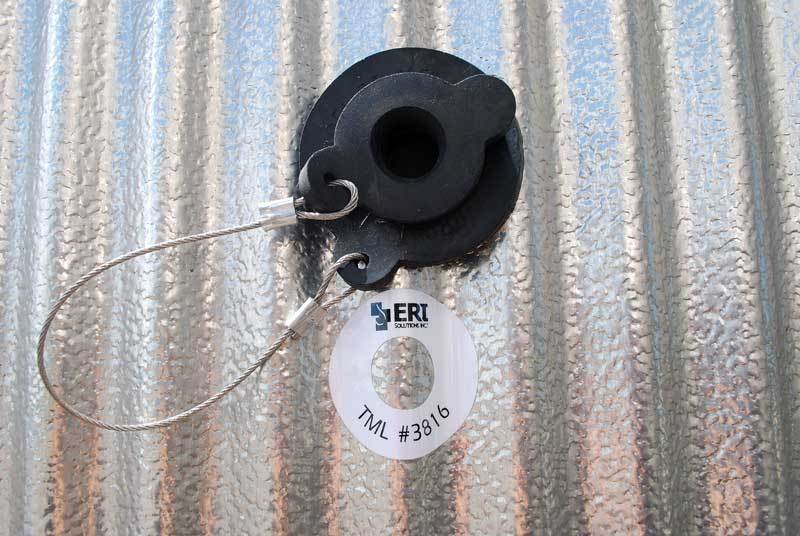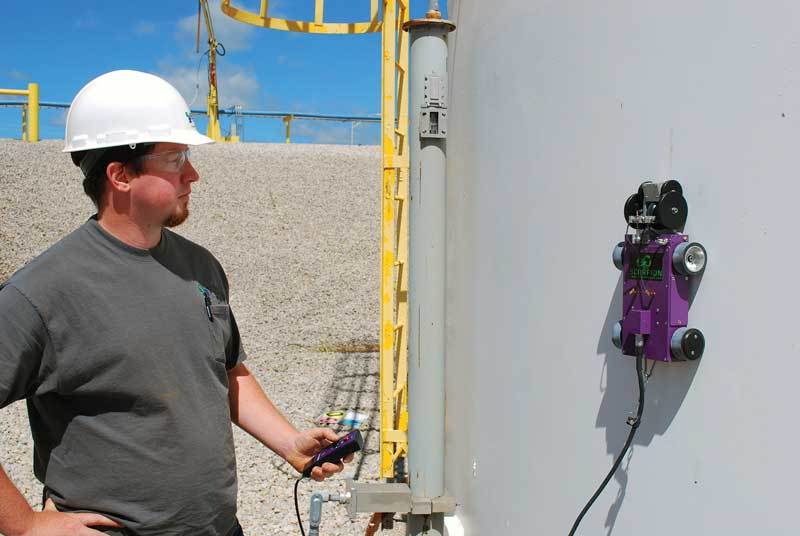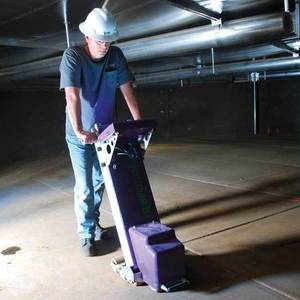The Integrity Initiative




PHOTO: ERI SOLUTIONS INC.
March 21, 2018
BY Tim Albrecht
Asset integrity management is generally defined as an operating procedure that protects equipment and its lifespan, while considering health, safety and environmental concerns. It’s an integral part of any operation, including every ethanol plant across the country.
The practice seems simple enough, and it is, according to Nathan Vander Griend, president of ERI Solutions Inc., but it needs to be routinely managed to prevent problems down the line. “It’s about making sure to keep the flammable stuff in the pipes, tanks and vessels. And making sure we’re aware when equipment needs to be replaced before it fails, or when equipment needs to be repaired or bolstered.
“Asset integrity management is really just saying, as equipment ages, it’ll begin to wear out. It’s no different than as a body ages it’ll begin to wear out. ... If equipment is allowed to get to its end of life without knowing that it’s coming, it could lead to an unnecessary downtime, catastrophe or fatality,” Vander Griend says. “There could be an unexpected downtime where the ethanol plant is out of business for six months while they wait for a specialty piece of equipment to be built.”
Active Management
Vander Griend says most of the ethanol industry has a pretty good handle on what asset integrity management looks like now, but active management is commonly overlooked. “I don’t think you’d find a plant out there that says, ‘We don’t need to do that; there’s no reason to do it.’ However, I do think you’d find several plants that have performed the required testing and inspections, but not sure exactly what they learned and their plan of action as a result.”
Vander Griend likens how ethanol plants handle the inspections to going to a doctor’s office for a checkup. The doctor might prescribe a battery of tests, but the patient doesn’t actually look at the results to understand them. “I think we have a little bit of not quite knowing what to do with the data that’s provided as a result of the testing and inspection process. We’ve built a tool we call AIM, which is a database for the ethanol industry specifically to anonymously benchmark testing and inspection data of assets in similar service, and actively manage their own testing and inspection data.
“We’re trying to show them visually what the data means,” Vander Griend says. “Because it’s a compliance activity, sometimes that report gets filed and they say, ‘Good, we did it.’ We want to make sure it gets into actively being managed.”
Dusty Turner, chief operating officer for Conestoga Energy Partners, says active management has been optimized at Conestoga’s three plants. “We looked at specific areas of the plant where we were performing preventative maintenance (PM) and found, in a lot of cases, we were doing it too frequently and not finding anything. Some areas we needed to be more thorough, and some areas we weren’t even looking at the right items and checking the right things. It’s a huge undertaking to rewrite and rework your PMs, so it’s been a work in progress, but it was probably one of the most beneficial things we did that first year.”
About four years ago, Conestoga noticed an increase in breakdowns on equipment that hadn’t broken down before, Turner says. “We were so focused, since we began in 2007, on production, efficiencies, fermentation, yield and all those kinds of things, and became accustomed to being really good firefighters. That just wasn’t cutting it. We had the production, the yield and all those things down fairly well, but we realized quick that in order to maintain the efficiencies we needed to meet, we had to do a better job of preventative maintenance, which led to more up time and less down time.”
Turner brought in Marshall Institute, a North Carolina-based asset management consulting firm, to work on preventative maintenance at Conestoga’s plants, focusing on total plant reliability to get the numbers in line. “In the first year, they brought in a lot of people and we failed miserably trying to execute and adopt a lot of their theories,” Turner says. “Their theories and training tools were great, but we tried to do too much, too quick. So, what we did is kind of backed up, and identified areas of our plant that were concerning and creating the most down time. We went down Marshall’s menu, if you will, and started implementing two or three things a year that would help us be more proactive and better manage our repairs.”
Predictive Maintenance
An active management plan makes predictive maintenance easier, monitoring equipment on a recurring basis versus performing maintenance when a problem arises. The strategy is intended to prevent unexpected equipment failures, with smaller, planned shutdowns, Turner says. “That’s where we spend 90 percent of our time.”
Contestoga’s three plants had 126 hours of downtime over and above their usual shutdowns, Turner says. Of those 126 hours, 45 percent of them were outside the plants’ control, usually involving something electrical. “What we focused on is how much of that downtime was unplanned, and of that unplanned downtime, 85 percent was jobs that we knew were going to happen. We were just trying to make it through the next shutdown, but when it went down, we had all the parts. So, even though it went down, we were prepared for it and totally mitigated that amount of downtime, because of our preventative and predictive maintenance philosophy.”
Some predictive maintenance involves technology and data feedback. Tech company ATEK Cos. Inc. provides services to “help the customer get their value out of predictive condition monitoring,” says Craig Truempi, director of Industrial Internet of Things Reliability at ATEK. “We essentially solve whatever problems a particular plant is having.
“One of the cases we had with an ethanol plant involved a hammer mill that was losing bearings on them more often than they felt it should be,” Truempi says. “We deployed some vibration and ultrasonic monitoring on the hammer mill to see what was happening on the machines over a 30-day period.” The ultrasonic data found that the hammer mill’s vibrations were erratic and high, signifying a lubrication problem. “They worked using the data to improve their lubrication practices and brought the ultrasonic levels back to normal, which resulted in longer life of their bearings.”
Truempi says predictive maintenance has been around for a long time but what ATEK does differently is use technology to make that maintenance quicker, easier and more cost effective. “We meet with customers directly, or through our channel, and work with them to solve problems that are having a financial impact.”
Regulation Changes
The Occupational Safety and Health Administration’s standards have made maintenance a must for the ethanol industry, but also have made some important changes to plant safety. Maintaining flammable areas is vital, Vander Griend says. “Testing and inspecting all the areas of the plant that have flammable liquids—such as distillation evaporation, dehydration, the tank farm, the loadouts, all that associated piping and equipment—are important because the flammability makes it a requirement under OSHA’s process safety management standard.”
OSHA regulations didn’t affect anything at Conestoga’s plants. In fact, they’ve adapted to the changes, Turner says. “We embraced that instead of letting it deflate our safety culture, and took it a step further and focused on things that have the potential for creating unsafe conditions and behaviors. No longer do we talk about a safety reward, or safety program, or anything like that. We’ve just incorporated our safety culture within our total plant reliability.”
Vander Griend says ERI highly recommends plants determine which equipment would render them inoperable if it were unusable. “They need to ensure they do not pigeonhole themselves into thinking OSHA’s PSM Standard tells them to only test and inspect required items. Rather, that’s the minimum and what should they test and inspect to start thinking about how they manage process safety and reliability? It’s important to evaluate what those assets are and, if those assets fail tomorrow, could a plant make ethanol the next day.”
Author: Tim Albrecht
Associate Editor, Ethanol Producer Magazine
701.738.4922
talbrecht@bbiinternational.com
Advertisement
Advertisement
Advertisement
Advertisement
Related Stories
The U.S. Energy Information Administration maintained its forecast for 2025 and 2026 biodiesel, renewable diesel and sustainable aviation fuel (SAF) production in its latest Short-Term Energy Outlook, released July 8.
XCF Global Inc. on July 10 shared its strategic plan to invest close to $1 billion in developing a network of SAF production facilities, expanding its U.S. footprint, and advancing its international growth strategy.
U.S. fuel ethanol capacity fell slightly in April, while biodiesel and renewable diesel capacity held steady, according to data released by the U.S. EIA on June 30. Feedstock consumption was down when compared to the previous month.
XCF Global Inc. on July 8 provided a production update on its flagship New Rise Reno facility, underscoring that the plant has successfully produced SAF, renewable diesel, and renewable naphtha during its initial ramp-up.
The USDA’s Risk Management Agency is implementing multiple changes to the Camelina pilot insurance program for the 2026 and succeeding crop years. The changes will expand coverage options and provide greater flexibility for producers.
Upcoming Events










